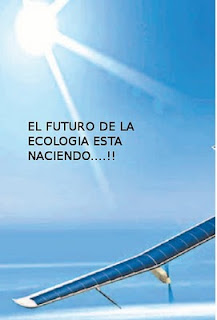
"The plane" Solar Impulse "
powered by solar energy and with which its developer, Bertrand Piccard, pl anea turn the world in 2012, completed its first flight by an hour and a half environmental technical innovation and has had a cost of $ 93.5 million.
environmental technical innovation and has had a cost of $ 93.5 million.
powered by solar energy and with which its developer, Bertrand Piccard, pl anea turn the world in 2012, completed its first flight by an hour and a half
 environmental technical innovation and has had a cost of $ 93.5 million.
environmental technical innovation and has had a cost of $ 93.5 million. The plane "Solar Impulse" exclusivamentepor powered with solar energy and its promoter, Bertrand Piccard plans to turn almundo in 2012, has completed its first flight by an hour and a half after landing at the military airfield in the Swiss town of Payerne. German rider Markus
Scherdel was the one who got the propellers of the "Solar Impulse" reached sumayor achievement to date, to the delight of the Swiss psychiatrist Piccard, who got the helicopter flight.
Scherdel was the one who got the propellers of the "Solar Impulse" reached sumayor achievement to date, to the delight of the Swiss psychiatrist Piccard, who got the helicopter flight.
The prototype took off at a speed close to that of a bicycle, about 45 kilometers per hour, peseaque63.4 meters separate the ends of their wings the same distance as a "Jumbo" - and losmil round her weight 600 kilos, more or less that of a car.
The flight was conducted at an average speed of 70 kilometers per hour, achieved thanks to the four motors of 10 horsepower each quemueven on a plane covered with some 12 000 solar cells.
The aircraft managed to fly in December a distance of 350 meters in Dubendorf airfield on the outskirts deZúrich, at a height of one meter, while this trip has been planned at a height of about a thousand meters.
Piccard's goal is that the prototype at a cost of 93.5 million, bypassed the world with five stops in five days within two years. However, the next challenge goes through an overnight flight scheduled for later this year, whose technical findings apartirde will build a new unit.
This project, which required five years of work, including simulations and construction, aims to demonstrate the potential of renewable energy, promote their use and demonstrate the energy savings can be achieved through new technologies.
In 1981, another solar ultralight aircraft with a pilot on board, called "Solar Challenger, flew from France to England in five hours. Piccard, an adventurer and grandson of the inventor of the bathyscaphe, Auguste Piccard, became in 1999 the first man to circumnavigate the world nonstop in a balloon.


0 comments:
Post a Comment